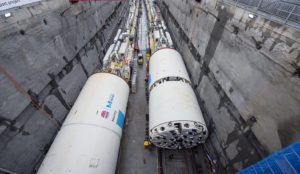MODUS, our modular system for automated deformation monitoring, is being used to permanently monitor the tracks of the Liège-Namur railway line in Belgium.
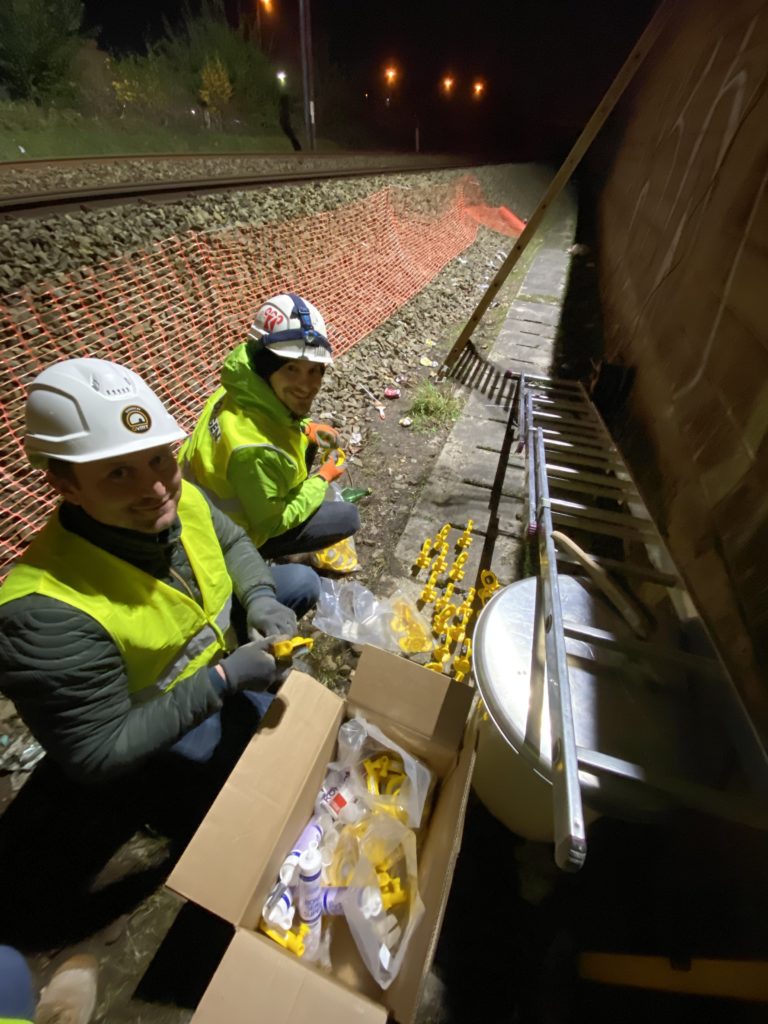 Here you can see our project engineers Viktor Marzinkowski and Vadym Tiroshko setting up MODUS connect and prisms on both sides of the sleepers.
Here you can see our project engineers Viktor Marzinkowski and Vadym Tiroshko setting up MODUS connect and prisms on both sides of the sleepers.
Great to be part of the Seraing Sowaer microtunnelling project with our partners NMBS-SNCB and K-Boringen nv!
Find out more about MODUS here.
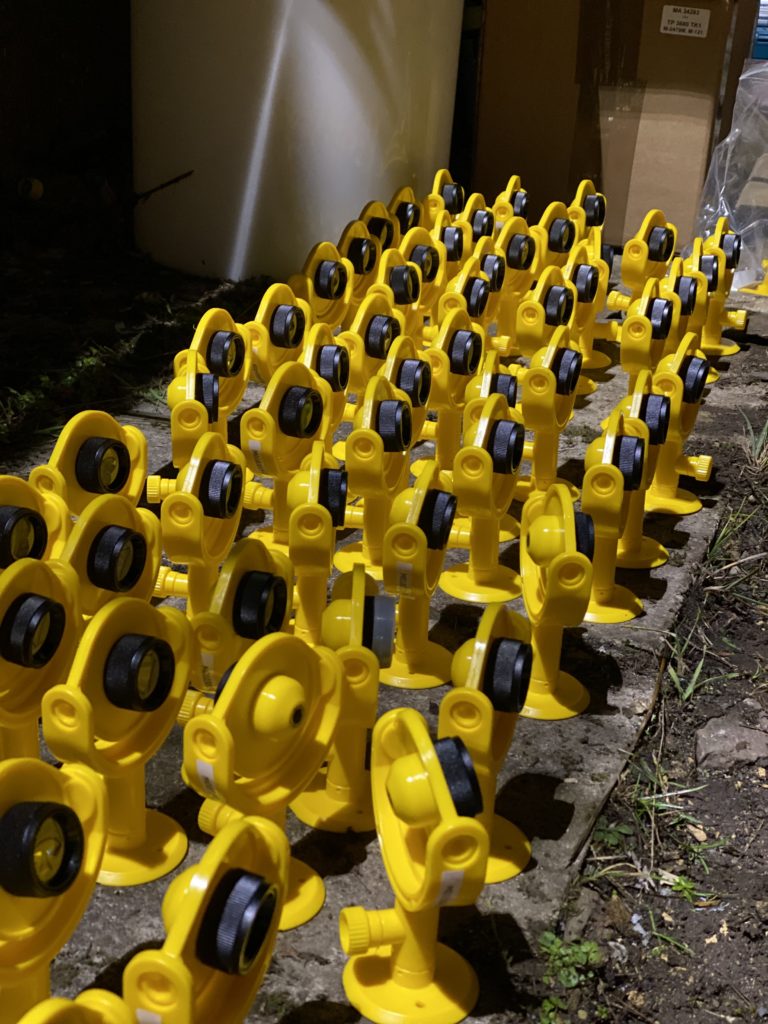
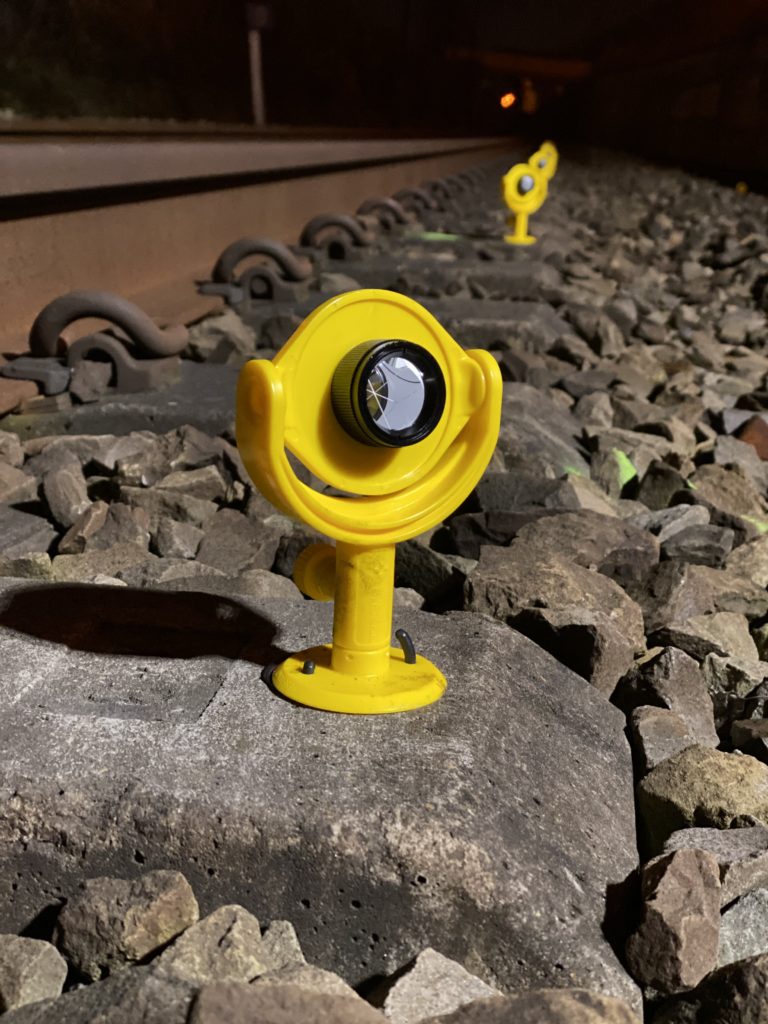
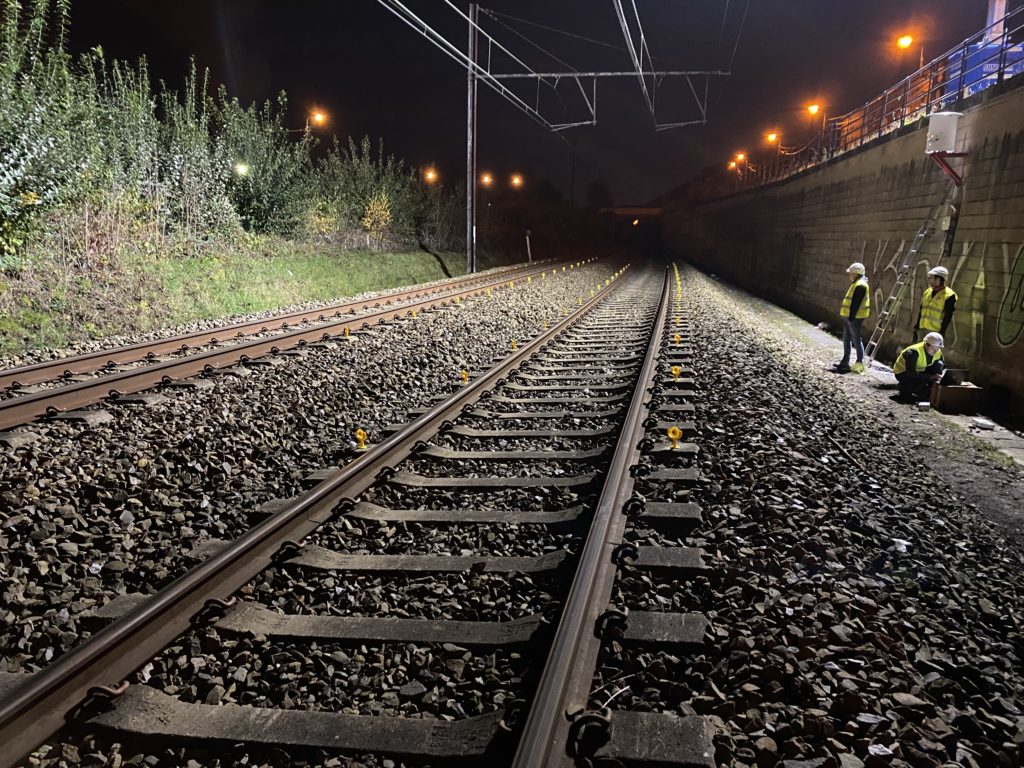
Safely packed, our TUnIS navigation systems are ready to start their journey across the globe.
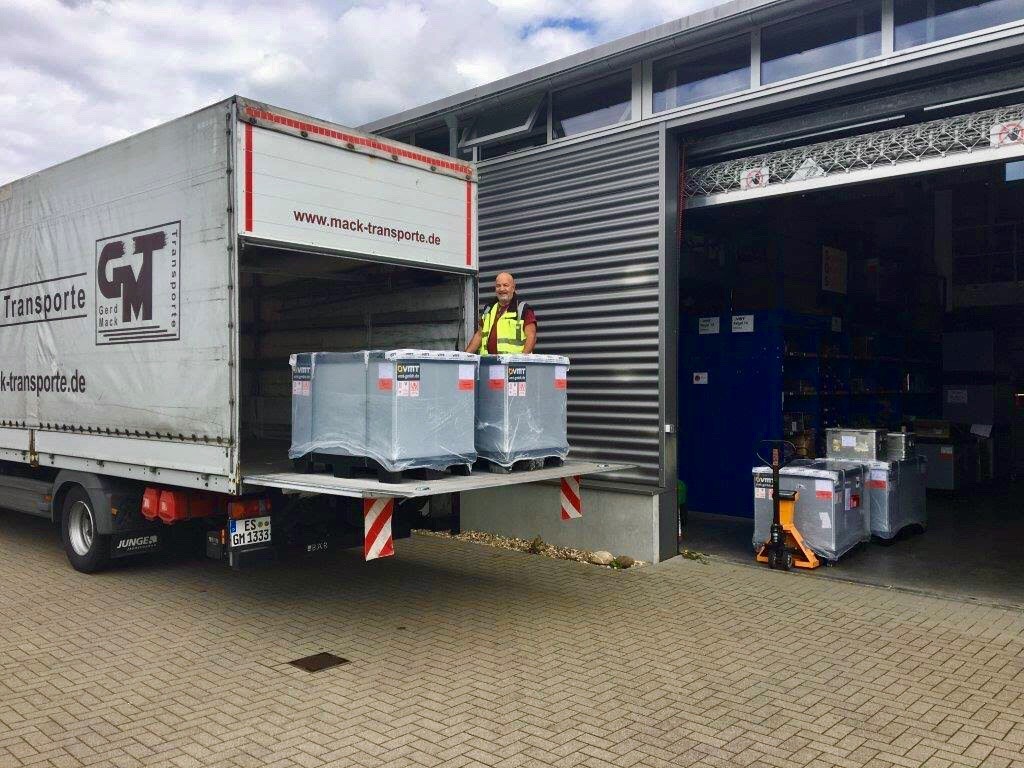
They’ll arrive in Sydney in just 5-7 days where they’ll be installed and commissioned by our Australian colleagues…and within a few short weeks they’ll be ready to go on the Roadheaders and Rockbolters which are digging the WestConnex 3A and 3B tunnels. Happy travels!
PS. How great is our Material Logistics team?! These guys handle around 1,000 of these shipments per year, making sure our products arrive intact and on time at construction sites all over the world.
The first ever pipe jacking in Finland broke through right on target after 3 bends and over 800m.
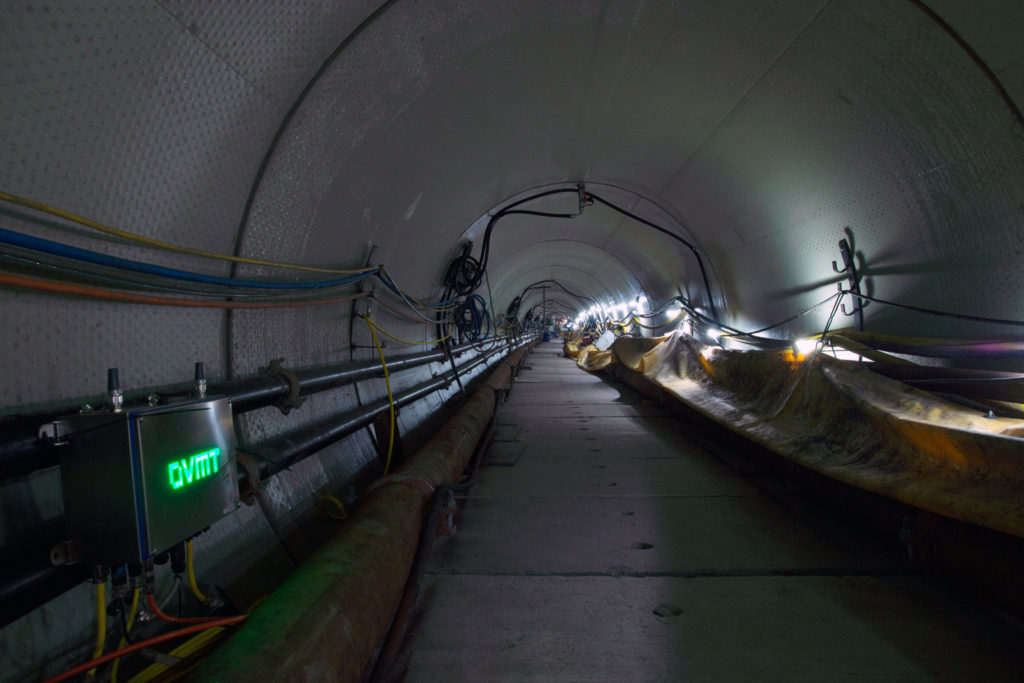
Congratulations and a huge thanks to our long-standing partner and customer Ward and Burke Construction Limited, who gave us the opportunity to extensively test the endurance of our new generation system TUnIS Navigation MT – in combination with the new hardware platform MT connect – throughout the project.
Martin Betsch, Microtunnelling Surveyor at Ward & Burke, was particularly taken with the WLAN network, stating: “The reliable WLAN that VMT’s new MT connect platform provides in the tunnel is a real advantage that not only simplifies the use of the navigation system, but also provides great support and time savings during repair and maintenance work in the tunnel”.
This awesome photo was taken onsite by our Senior Project Engineer, Daniel Weiß. Read more about our new TUnIS Navigation MT system here.
The Koralm Tunnel, the sixth-longest railway tunnel in the world, forms a 32.9 km long section of the new 130 km long Koralm Railway, which on completion will connect the Austrian cities of Graz and Klagenfurt in the southeast of the country.
Click here to jump to the testimonial statement.
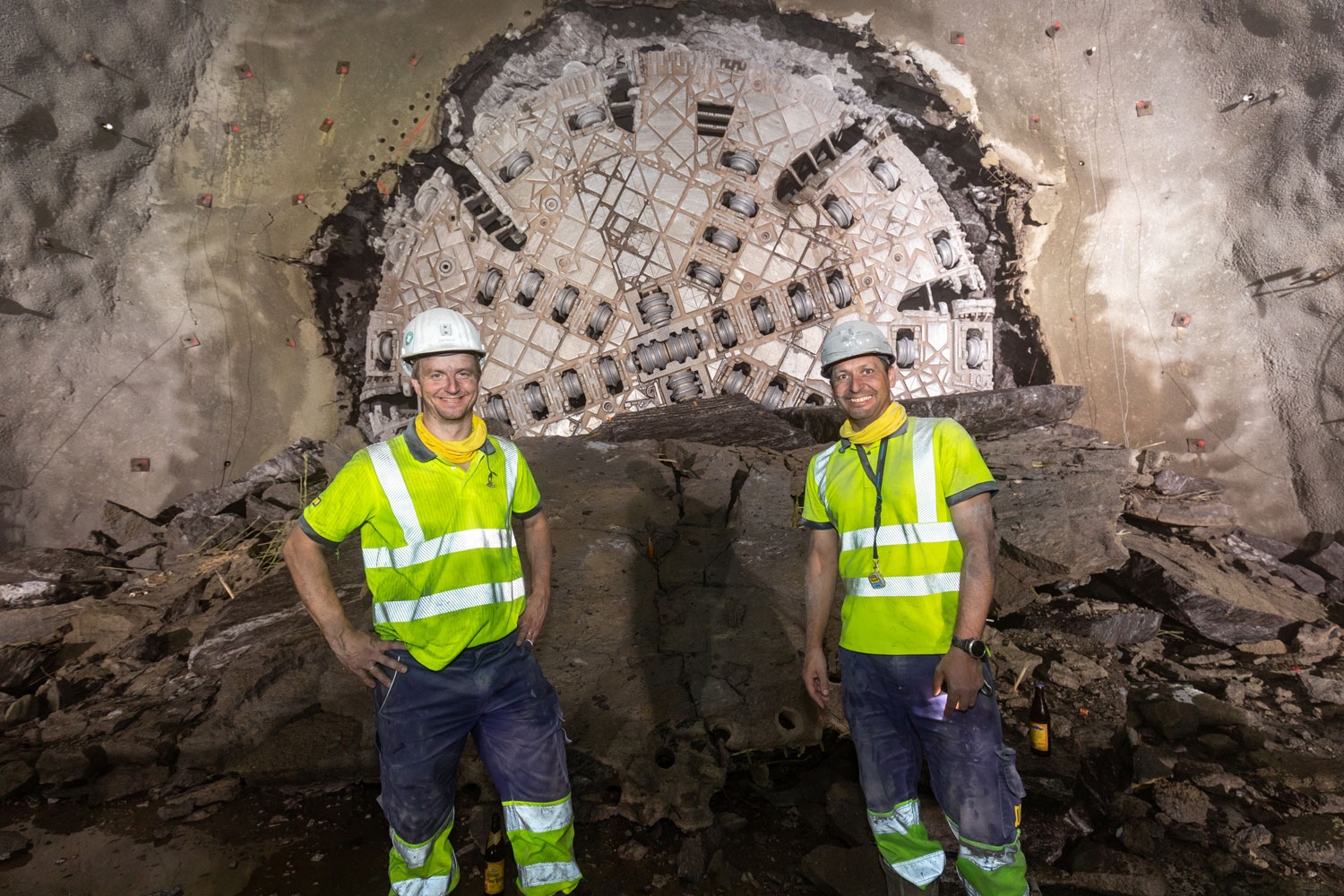 The new railway line will comprise 47 km of tunnels, have over 100 bridges and 23 modern railway stations and stops along the route. The project is being hailed as one of the most important transport infrastructure projects currently underway in Europe. The construction of the project is due to be completed by 2023 with the route being fully operational by 2025.
The new railway line will comprise 47 km of tunnels, have over 100 bridges and 23 modern railway stations and stops along the route. The project is being hailed as one of the most important transport infrastructure projects currently underway in Europe. The construction of the project is due to be completed by 2023 with the route being fully operational by 2025.
The Koralmtunnel KAT3 construction lot recently broke through completing the last of Koralm Tunnel drives in St. Paul im Lavanttal, Carinthia, Austria. A Herrenknecht 9.94 m diameter Multi-mode TBM was used. This type of machine has the capacity to operate in both EBP and open modes to cope with changing ground conditions along the drive. This particular length of tunnelling work covered the final 10.474 km of the tunnel and included a curve with a minimum radius of 3,000 m. The drive commenced in October 2015 and was recently finish on the 17th of June 2020.
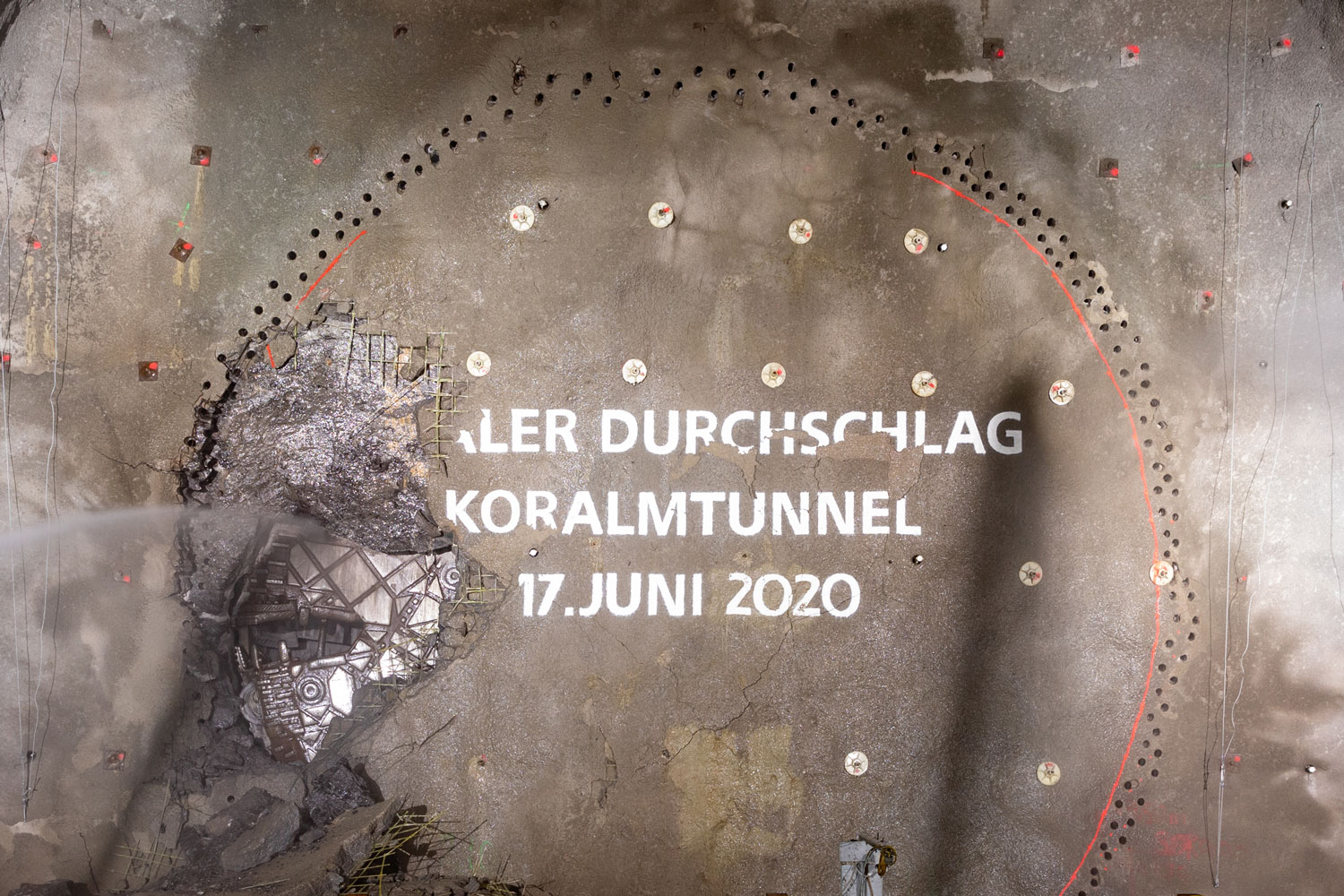
The multi-mode design of the TBM was necessary because for about the first 4 km of the drive the TBM drove through sedimentary rocks of the Neogene period and through the Laventtal main fault zone in EPB mode. In June 2018, after two months of conversion work, the TBM started driving the remaining 6 km (approximately) in the open hard rock mode.
The construction site is owned and managed by major infrastructure contractor PORR which has had a long-term relationship with both Herrenknecht and VMT in connection with other tunnelling projects.
To support tunnelling, VMT supplied the necessary navigation and other site management systems including TUnIS Navigation TBMLaser system alongside TUnIS Navigation Office software, VMT’s TUnIS Ring Sequencing system, SLuM Ultra (VMT’s Automatic Tailskin Clearance Measurement System) and VMT’s RCMS (Ring Convergence Measurement System). The VMT systems were purchased as part of the TBM contract and mainly installed during the machine build. The RCMS system was installed later during the course of 2019.
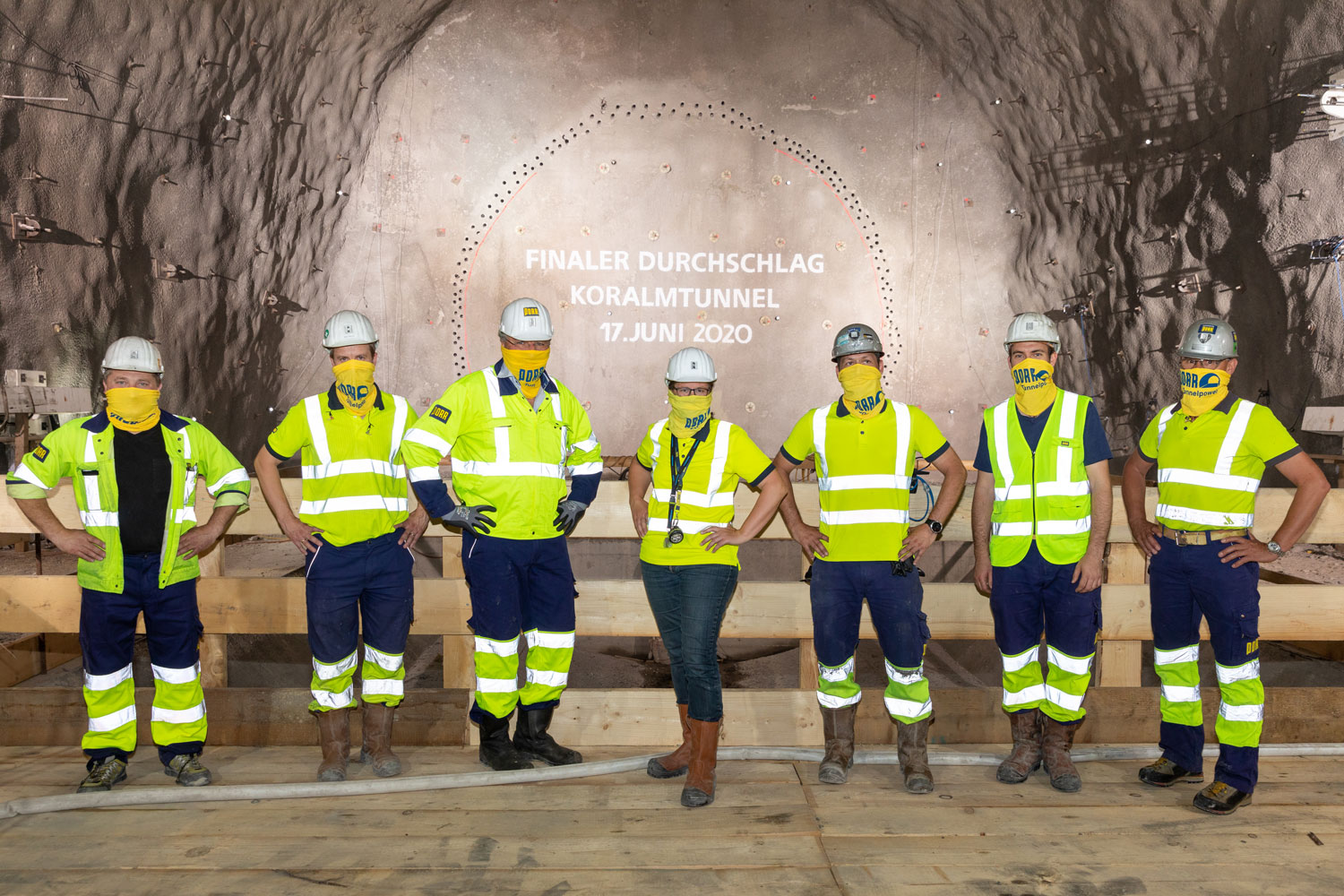 VMT engineers also provided on-site training for project staff during the course of the project as well as the purchasing of spare parts when required for the navigation system.
VMT engineers also provided on-site training for project staff during the course of the project as well as the purchasing of spare parts when required for the navigation system.
The site team also worked with the VMT team to site test various other VMT products which included the new central box LDT.connect and the ELS3G target unit.

Testimonial Statement from Joachim Geißbauer, site manager for KAT3
“Koralm Tunnel Construction Stage KAT3: 10,500 m through most difficult geology
The task
The Koralm railway is part of the new southern railway line. The heart of this new line is the approximately 33 km long Koralm tunnel which connects the two provinces of Carinthia and Styria.
The Koralm tunnel is being built in three construction stages. The third and last construction stage KAT3 extends over a length of around 12 km and will be driven in the north tunnel, for the most part with a tunnel boring machine. The Koralm tunnel crosses the massive Koralpe mountain range with a maximum overburden of about 1,200 m. The two tunnels run with a centre distance of around 40 m and are connected to each other every 500 m by cross-sections. Due to the project length at the KAT3 construction stage of about 11 km, it was necessary to efficiently connect and evaluate the data from segment production, the tunnelling (TBM data) and the surveying work as well as the results of the geological and geotechnical monitoring.
With the support of VMT GmbH and its products, the machine and survey data could be collected and merged.
Furthermore, in geologically challenging areas, the RCMS convergence measurement system was able to produce a condensed record of the ring convergences, which was also linked to the existing survey data from the tunnelling.
Project advantages
- Thanks to good cooperation between an experienced customer and experienced service experts from VMT, the challenging drive was masterfully executed through to the final breakthrough
- Due to the long construction period of about 5 years, it was periodically necessary to overhaul the systems used or to adapt them to changing specifications. The employees of VMT GmbH always completed this task to the utmost satisfaction
- Thanks to VMT’s service support, all the client’s key requirements were met and the tunnelling work was completed successfully”
At a Glance Fact Sheet:
|
Sydney Metro is the biggest public transport project in Australia, and it is currently being extended to cover the City and Southwest districts of Sydney.
Click here to jump to the testimonial statement.
The current work program involves the construction of 15.5 km twin tunnel using five (5) Tunnel Boring Machines (TBMs) working concurrently across the tunnel route. Four TBMs are Herrenknecht double shield machines and one single shield machine. Other sections of the tunnelling works, mainly for the station cavern construction, involve the use of 13 roadheader machines along with seven (7) rockbolter rigs. The tunnelling works are being carried out by the joint venture tunnelling contractor John Holland CPB Ghella Joint Venture.
At the end of April 2020, the final TBM drive was completed holing out at Blues Point after it had tunnelled 885 m from Barangaroo, up to 40 m deep under Sydney Harbour.
Supporting the project, VMT has provided equipment and site support for the TBMs, roadheaders and rockbolters with a variety of navigation systems for each of the tunnelling systems types as well as its Segment Documentation System (SDS). The navigations systems were also supported by VMT’s TUnIS Navigation Office software.
The navigation systems include:
- TUnIS Navigation for each of the Double Shield machines
- TUnIS Navigation for the Single Shield machine
- TUnIS Navigation systems for each of the Roadheaders
- TUnIS Navigation systems for each of the Rockbolters
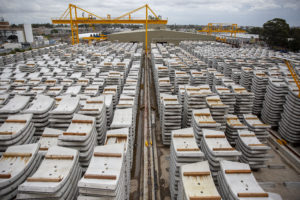 As well as this more traditional equipment, VMT has also introduced for the first time its TUnIS.mono cam. TUnIS.mono cam was specially designed for the navigation of Double Shield TBMs and is used to determine the position and situation of the front shield in relation to the gripper shield in 3 dimensions by using a camera located in the gripper shield and special targets on the front shield.
As well as this more traditional equipment, VMT has also introduced for the first time its TUnIS.mono cam. TUnIS.mono cam was specially designed for the navigation of Double Shield TBMs and is used to determine the position and situation of the front shield in relation to the gripper shield in 3 dimensions by using a camera located in the gripper shield and special targets on the front shield.
On double shield machines, the position and situation particularly of the front shield must be known. From a structural perspective, this is usually very complicated to determine using a conventional laser system. A complex system is used for the relative position and situation determination of the front shield compared to the gripper shield involving multiple components including a laser, laser target, inclinometer and a cylinder stroke measurement system, all of which requires a lot of room and complicated cabling and sensors.
With TUnIS.mono cam, VMT has now created a solution that needs only a single active component and is correspondingly simple to install, saving space and providing a system is unlikely to be problematic.
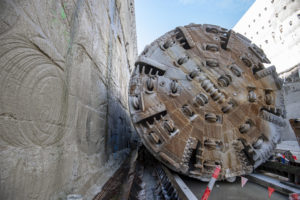 TUnIS.mono cam is a complementary system that is used with the main system, a laser-based navigation system. The main system determines the position and situation of the gripper shield. Based on this, TUnIS.mono cam then determines the position and situation of the front shield.
TUnIS.mono cam is a complementary system that is used with the main system, a laser-based navigation system. The main system determines the position and situation of the gripper shield. Based on this, TUnIS.mono cam then determines the position and situation of the front shield.
TUnIS.mono cam works photogrammetrically: to do so, an appropriate camera is installed in the gripper shield. Special markers are applied and surveyed in on the front shield. During operation, the system recognises the markers in the camera image and uses them to calculate the 3-dimensional position of the front shield in relation to the known position of the gripper shield. The most modern image measuring software is used for this along with sophisticated calculation algorithms.
The benefits of the new TUnIS.mono cam include:
- The system does not require a laser, laser target, inclinometer or cylinder stroke measurement system, making it a simple, fast and space-saving setup
- Minimal cabling is required in both the front and gripper shields
- It offers continuous availability of current data due to increased measurement frequency
- Reduced repair costs due to lack of damage to susceptible and expensive sensors
- The system is virtually maintenance-free
- Compared to laser-based systems, there is an increased field of vision which means it can be used in tight curves.
 Given this was the first use of the new TUnIS.mono cam, VMT’s Gerlinde Grom interviewed two of John Holland CPB Ghella JV’s senior surveyors, Thomas Pascoe (TP) and Reto Salvisberg (RS), on the effectiveness of the new system.
Given this was the first use of the new TUnIS.mono cam, VMT’s Gerlinde Grom interviewed two of John Holland CPB Ghella JV’s senior surveyors, Thomas Pascoe (TP) and Reto Salvisberg (RS), on the effectiveness of the new system.
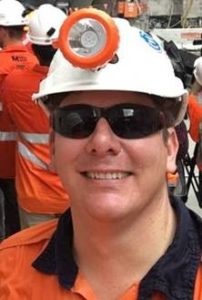
Senior surveyor Thomas Pascoe
Did you feel comfortable with the navigation system from VMT?
Yes (TP)
Yes (RS)
Did this VMT solution generally fulfil your expectations – did it perform as expected?
Yes (TP)
Yes. I have used many previous versions of the VMT Double Shield Navigation System, and this camera system is a very big improvement. This system works well under all extreme conditions such as high vibration or excessive front shield roll/articulation. (RS)
Did you feel confident in the results offered and the position calculated by the camera system?
Yes (TP)
Yes (RS)
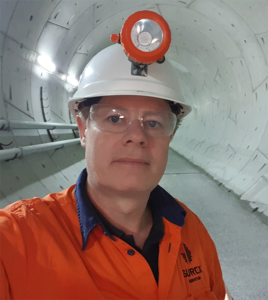
Senior surveyor Reto Salvisberg
Is there anything specific you would like to say about the new system in terms of visibility, cleaning of the system and Tunnel Proofing of the set up?
There was good visibility on the system. The camera system generally was able to track 14 or more system markers even through the tighter curves. Also we did not have to clean the markers as often as I might have expected, occasionally yes but not often. In terms of ‘Tunnel Proofing’ we covered the camera with a protective shield to prevent rock/mud ingress and the system and its mount seemed stable. (TP)
I agree the system has good visibility. Illumination of the markers was available as there was a light mounted beside the camera. Cleaning of the markers was sometimes necessary but not too often. When installing the camera we made sure it had a cover over the top especially as it was mounted directly under the front of the gripper shield. This was necessary as sometimes rocks come through the gap when the front shield was fully extended. (RS)
How was the handling with the navigation system?
System was easy to use. (TP)
This system was easy to use. (RS)
What main benefits did the system deliver and do you have any ‘hard figures’ that prove these benefits such as cost reductions, reduction in staff, time on site etc.?
The position shown by the VMT system was very similar to the wriggle survey taken. This meant the VMT system real-time wriggles were very reliable and useful for possible steering corrections. It was great to have worked with this system and be one of the first to use it exclusively with no backup in place. It offers a very reliable and robust system. (TP)
The hardware was reliable and there was no downtime due to equipment failure. (RS)
How well did the collaboration with VMT work both during the set-up and operational periods?
VMT’s support was good for the start-up and install process. The VMT engineers’ knowledge of system was good as was the training provided to our site surveyors and engineers. During the operational phase from a survey navigation viewpoint the system was easy to use, therefore little input required. Remote support was also available via ‘teamviewer’ which was also helpful. (TP)
Support from VMT was very good at all times during commissioning and during the tunnelling process. (RS)
Would you look to utilise this VMT solution and have VMT as partner again?
Yes and I am looking forward to the next project! (TP)
Yes (RS)
Responding to some of the points highlighted during the interview VMT’s engineer, Gerlinde Grom, Senior Project Engineer at VMT said: “In terms of visibility in total there are 16 markers in the system. To calculate the shield position, we use at least 6 to 8 markers. So, if there are 14 markers or more visible all is well. Our initial design provided for a camera light to illuminate the markers. It was also useful to hear the comment about the camera cover. We will mount this on all installations in future. It was also good to hear that the camera is ‘Tunnel proof’ and that there were no issues due to vibration etc. It was also a good result that the wriggle surveys matched very closely. This shows that the installation of the brackets by the contractor was good which made for a good survey to the front of the TBM, even with the limited space given that the measurement across the TBM gantry was necessary.”
At a Glance Fact Sheet:
|

